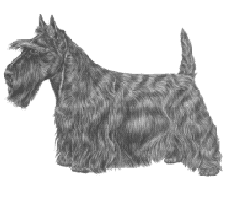Scottish Terrier
General Information - Scottish Terrier

Group:
Terrier
Size:
medium
Lifespan:
11-13 years
Exercise:
moderate
Grooming:
moderate
Trainability:
very hard
Watchdog ability:
very high
Protection ability:
low
Area of Origin:
Scotland
Date of Origin:
1800s
Other Names:
Aberdeen Terrier,
Scottie
Original Function:
Vermin hunting
History
The Scottish Terrier was developed in Scotland in 1700, but the dog with the size and shape we know today dates from 1890. The breed was first called the Aberdeen Terrier, after the Scottish town of the same name. Like many other long-low breeds, the Scottie was used to hunt den animals, particularly otter, fox, badger and Rabbit. Today this stylish breed is primarily a companion, though he still retains his hunting instincts.
Temperament
The Scottish Terrier is a self-assured and alert dog breed that makes a good watch dog. Loyal with their owners, the Scottish Terrier may be aloof with strangers and aggressive with other dogs.
Upkeep
This is a dog on the lookout for adventure, and it needs some excitement and exercise in its life every day. This can take the form of a moderate walk on leash, a boisterous game or an off-leash exploration in a safe area. Although it could live outdoors in a temperate to warm climate, it is far better suited as a house dog with access to a yard. Its wire coat needs combing two to three times weekly, plus shaping every three months. Shaping for pets is by clipping and for show dogs by stripping.
Scottish Terrier
A breed standard is the guideline which describes the ideal characteristics, temperament, and appearance of a breed and ensures that the breed is fit for function with soundness essential. Breeders and judges should at all times be careful to avoid obvious conditions and exaggerations, as well as being mindful of features which could be detrimental in any way to the health, welfare or soundness of this breed.
Breed Standard - Scottish Terrier
 General Appearance:
General Appearance: A Scottish Terrier is a sturdy thick:set dog of a suitable size to go to ground, placed on short legs, alert in carriage and suggestive of great power and activity in small compass. The head gives the impression of being long for a dog of its size. The body is covered with a close-lying, broken, rough-textured coat; with its keen intelligent eyes and sharp prick ears, the dog looks willing to go anywhere and do anything. In spite of its short legs, the construction is such that it is a very agile and active dog. The movement of the dog is smooth, easy and straight forward, with free action at shoulder, stifle and hock.
Head and Skull: Without being out of proportion to the size of the dog, it should be long, the length of skull enabling it to be fairly wide and yet retain a narrow appearance. The skull is nearly flat and the cheek-bones do not protrude. There is a slight, but distinct stop between skull and foreface just in front of the eye. The nose is large and in profile the line from the nose towards the chin appears to slope backwards.
Eyes: Should be almond-shaped, dark brown, fairly wide apart and set deeply under the eyebrows.
Ears: Neat, of fine texture, pointed and erect.
Mouth: The teeth large, the upper incisors closely overlapping the lower.
Neck: Muscular, of moderate length.
Forequarters: The head is carried on a muscular neck of moderate length, showing quality, set into a long sloping shoulder; the brisket well in front of the forelegs, which are straight and well-boned to straight pasterns. The chest fairly broad and hung between the forelegs, which must not be out at elbows nor placed under the body.
Body: The body has well-rounded ribs, which flatten to a deep chest and are carried well back. The back is proportionately short and very muscular. In general the top line of the body should be straight and level; the loin muscular and deep, thus powerfully coupling the ribs to the hindquarters.
Hindquarters: Remarkably powerful for the size of the dog. Big and wide buttocks. Thighs deep and muscular, well bent at stifle. Hocks strong and well bent and turned neither inwards nor outwards.
Feet: Of good size and well padded, toes well arched and close:knit.
Tail: Of moderate length to give a general balance to the dog, thick at the root and tapering towards the tip, set on with an upright carriage or with a slight bend.
Coat: The dog has two coats, the undercoat short, dense and soft; the outer coat harsh, dense and wiry; the two making a weather-resisting covering to the dog.
Colour: Black, wheaten or brindle of any colour.
Weight and Size: The ideally made dog in hard show condition should weigh from 8.6 kg (19 lb) to 10.4 kg (23 lb).
Height 25.4 to 27.9 cm (10 to 11 in).
Note: Male animals should have two apparently normal testicles fully descended into the scrotum.
DNZ No 268
Copyright Dogs New Zealand
01 Jan 2002
Any departure from the foregoing points should be considered a fault and the seriousness with which the fault should be regarded should be in exact proportion to its degree and its effect upon the health and welfare of the dog and on the dog’s ability to perform its traditional work.




